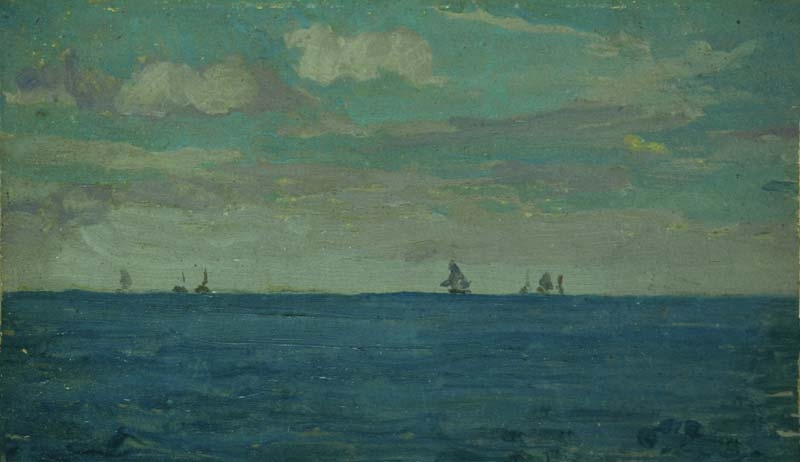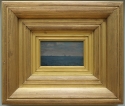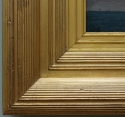Home > Catalogue > Browse > The Sea, Brittany << >>
Technique
It is on a 2 mm thick softwood panel – probably pine – made from a single piece of timber, with a 2 mm shallow bevel on all sides on the verso. It was primed unevenly (the surface is slightly lumpy) with pale grey priming, which runs over the edges, but was, for once, well covered by the paint.
Whistler used a fairly small brush, less than 2 mm wide, but on such a small panel the brushwork seems surprisingly broad. The blue sea was painted thinly, wet-in-wet. The sky, warm grey clouds, with touches of pale blue, turquoise and greenish-yellow, are painted with soft brush-strokes. The sea may be cobalt blue and the sky is a different blue, likely Prussian blue. 1
Conservation History
The short edges were damaged while the paint was wet, by sliding the panel into the box, and in addition all the edges of the painting were damaged by the frame.
Lead soap formation in the paint has produced tiny pimples on the surface. The varnish is very yellow varnish, and more yellow under the frame. Otherwise the panel is in good condition. 2
Frame
Grau Whistler, signed 'F H Grau - London', 1892, 33.0 x 38.9 x 5.5 cm. 3 It was made by Whistler's favourite frame-maker, Frederick Henry Grau (1859-1892). Dating from about 1892, it suggests that the picture was intended for exhibition but, if so, no such exhibition has been identified.
Notes:
1: Dr Joyce H. Townsend, Chief Conservator, Tate Britain, Report of examination, August 2017. The cobalt blue has a faint fluorescence under ultra-violet light, and the other blue was identified under infra-red as possibly Prussian blue.
2: Clare Meredith, condition report, 23 April 2001, Hunterian files. Townsend 2017, op. cit.
3: Dr S. L. Parkerson Day, Report on frames, 2017; see also Parkerson 2007 [more].
Last updated: 22nd October 2020 by Margaret








